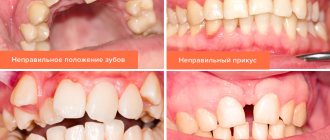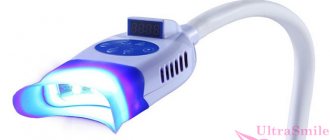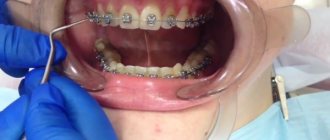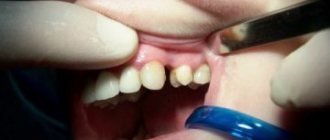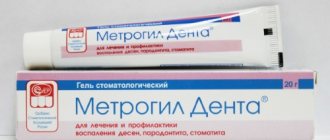Five important questions about how to insert teeth
Before describing technologies for restoring lost teeth, we will briefly answer the most popular questions that interest almost all patients who are faced with the need for prosthetics for the first time.
- Do I need to replace teeth if I have lost them?
Dentists recommend doing this immediately and without fail. Even if the emptiness in the dentition is unnoticeable, do not delay your visit to the clinic. Lack of timely treatment leads to resorption of bone tissue, displacement of the dentition, deterioration of the bite, and can cause changes in the shape of the face and problems with the digestive system. - What teeth can be inserted?
Absolutely everything: natural incisors, canines, molars and premolars can be successfully replaced with dentures. - Does it hurt to put teeth in?
Many patients familiar with the methods of Soviet dentistry are concerned about the question of whether it hurts to insert teeth? We hasten to reassure you: modern methods of anesthesia make the treatment absolutely painless. - How long does it take to insert teeth?
It all depends on the treatment method, the efficiency of the doctors and the dental laboratory. Temporary teeth can be inserted in one visit; permanent dentures require more time. - What is the name of the doctor who inserts teeth?
The doctor who inserts teeth and performs prosthetics is an orthopedic dentist, but treatment and preparation for procedures is usually carried out by a whole team of specialists: dental surgeons, dental therapists, dental technicians.
Advantages and disadvantages of anterior dental implants
The most important advantage of front teeth implantation is the ability to quickly restore the smile area by replacing a lost tooth with a dental implant with a crown that will look as natural as possible. If the operation is performed efficiently and the patient follows all care recommendations, the new tooth can last for many years or even a lifetime.
The disadvantages are associated primarily with the possibility of postoperative complications: inflammation, bleeding, swelling, and in rare cases, implant rejection. If the implantation of the upper anterior teeth is carried out with a sinus lift, then there is a risk of inflammation of the maxillary sinus. At the SmartLine clinic, the likelihood of complications is minimized: we employ experienced doctors who have been performing such operations for more than 15 years; before surgery, the patient undergoes a thorough X-ray diagnosis to identify chronic diseases and individual characteristics of the structure of the upper jaw.
All modern methods of restoring lost teeth
Just 20 - 30 years ago, metal teeth in the front part of the jaw were not considered something shameful. Moreover, many dreamed of inserting gold teeth, since a golden smile was associated with wealth. Today, dental treatment is technologically advanced, effective and painless, and there are many more ways to insert teeth. Despite the variety of dental services, it is very important for the patient to find good dentistry and a competent specialist who will provide professional assistance. There are hundreds of reviews online where people complain that their teeth were inserted poorly or that the inserted tooth hurts. Unfortunately, such consequences are not uncommon, and their elimination requires repeated treatment and additional costs.
All prosthetic methods are divided into two types: single restoration and complex prosthetics (when you need to replace several lost units or insert complete teeth). Single restoration in most cases is carried out using special inlays (veneers or lumineers) and crowns that are installed on natural teeth or implants. When several teeth are lost or completely edentulous, bridges or removable dentures are used, supported by implants, natural teeth or the oral mucosa. Let's look at these designs in more detail and start with regular dental crowns.
- Metal-ceramic teeth
The crown is based on a metal frame, onto which layers of ceramic are applied under the influence of high temperatures. Such designs are relatively inexpensive and are used for prosthetics of front teeth. Metal tends to oxidize, so over time a bluish outline may form around the gums, which has a bad effect on aesthetics. - Ceramic tooth
These crowns are indistinguishable from natural teeth. Modern ceramics are installed both on the anterior units and on the chewing teeth. The price of ceramic crowns is perhaps their only drawback. The cost of such products is higher than that of similar structures using a metal base. This is why not every patient can afford to have a ceramic tooth inserted. - Zirconium teeth
Today, zirconium dioxide crowns are considered the best of similar designs available on the market. They are as durable as metal crowns, and in aesthetics they are not inferior to ceramic structures. With the help of zirconium crowns, teeth are successfully inserted in any area of the jaw, but when planning to restore lost units, take into account the fairly high cost of such crowns.
Prosthetics with artificial crowns and bridges –
Many different materials are used to make crowns, differing in strength and aesthetic properties. Therefore, if you decide to insert teeth, the price of crowns made of different materials will differ markedly from each other. Most often, artificial crowns are made from metal ceramics (when the internal metal frame is lined with ceramic mass), or from metal-free ceramics - porcelain, zirconium dioxide, or lithium disilicate.
For fixed dental prosthetics, the prices below will be indicated for 2020 (prices are indicated for clinics in the middle price category).
Cost of dental prosthetics with metal-ceramics –
Can be used for prosthetics of both anterior and chewing teeth. They have an affordable cost and acceptable aesthetics (although it is clear that their aesthetics will be inferior to the aesthetics of crowns made of metal-free ceramics). For the restoration of front teeth, metal-ceramics is not suitable for all patients, and the important point is that in some people the enamel of the front teeth has a high coefficient of transparency, in others it is almost opaque.
A metal-ceramic crown under a layer of ceramic has a metal frame that prevents the passage of light, which means such crowns will be completely opaque. Therefore, if you have high enamel transparency and if you only need to restore single front teeth, this can lead to the fact that the restored tooth will be very different from the neighboring healthy teeth. But when using prosthetics for chewing teeth, the issue of aesthetics is no longer so important.
Metal-ceramic dental prosthetics: before and after photos
In addition, metal ceramics can be very different in quality, and the cost range for 1 crown can be from 5,500 to 16,000 rubles. The difference in price depends not only on the quality of the metal used for the metal frame, but also on the ceramic mass (for example, cheap ceramic mass will definitely mean poor aesthetics, as well as a higher risk of chipping the ceramic). The most important point will be to take into account the crown manufacturing technology.
For example, in addition to traditional metal-ceramics, there is also the so-called metal-ceramics with shoulder mass, which allows you to achieve good aesthetics of the gums around the crown. After all, the main disadvantage of traditional metal-ceramic crowns is not only their complete opacity, but also the fact that they give a pronounced bluish appearance to the gums, which looks very unsightly when smiling. Therefore, if you want to restore your front teeth, it is better to choose metal-ceramics with shoulder mass (more details in the link above).
Dental prosthetics with metal-ceramics: prices
1) The cost of 1 unit of metal ceramics on a cast metal frame made of a traditional cobalt-chromium alloy using inexpensive ceramic mass such as “Duceram” (Germany) will cost about 10,000 rubles. If a higher quality ceramic mass is used on the same frame - it could be “Noritake” (Japan) or “Ivoclar” (Liechtenstein), then the price will be about 15,000 rubles for 1 crown.
And when using very high-quality and expensive ceramic mass “Vita” (Germany), the price will be about 18,000 rubles for 1 crown. At the same time, if the crown is made with the so-called “shoulder mass”, then add approximately another 5,000 rubles to the prices indicated above.
2) If the metal frame is made not by casting, but by milling on a computer-controlled machine (using CAD\CAM technology), then the cost of 1 crown will be about 20,000 rubles. This method of making a frame will make it possible for the crown to fit as closely as possible to the tissues of the tooth in the area of its neck. This is the most important guarantee that the crown will last as long as possible.
3) The cost of one unit of metal ceramics on a gold-platinum alloy is about 20,000 rubles. The use of noble metal alloys is necessary for some patients who are allergic to traditional metal alloys. It is also better than cobalt-chromium alloy in terms of aesthetics, because... gold will give the ceramic mass a natural tint, which is characteristic of natural tooth enamel. At the same time, you must take into account that the cost of dental gold will be added to this cost (+ 5,000 rubles per 1 gram).
4) When making temporary crowns from plastic (they are made so that the patient does not have to wear his teeth ground down for about 2-3 weeks while permanent crowns are being made), the cost of the work will increase by another 1,500 rubles (for each plastic crown).
Important: prices for such dental prosthetics can be lower, for example, you can probably find such crowns for 6,000-8,000 rubles. At such low prices, only the most inexperienced dental technicians will make crowns in a dental laboratory, and the crowns themselves will most likely be made from Belarusian or Russian materials (metal, ceramic mass), which is fraught with:
not very good or downright bad aesthetics,- cracks in the metal frame,
- chipped ceramics.
If you want crowns to be indistinguishable from neighboring healthy teeth and to serve you for 8-10 years, then you should not look for the lowest price (otherwise they will look no better than in Fig. 4). For example, the crowns in Fig. 4 objectively cannot cost more than 6,500 rubles for 1 crown, because their color is frankly bad, and there is no transparency even along the cutting edge, where there is no metal frame. But unfortunately, this quality of work in Russia is rather the norm. But the much more aesthetic crowns in Fig. 5 should cost about 15,000 rubles per unit.
Price of prosthetics with ceramic crowns –
Ceramics for artificial crowns and bridges can be of several types. The simplest and most inexpensive option, which is only suitable for restoring severely damaged crowns of front teeth, is feldspathic ceramics (porcelain). It is undesirable to make porcelain crowns on chewing teeth due to their low strength, and as a result, this type of ceramic is completely unsuitable for the manufacture of bridges. Thus, the good aesthetics of porcelain are combined with its low reliability.
The second option is ceramic crowns made of a material such as zirconium dioxide. In the manufacture of these crowns, modern milling technology is used on a computer-controlled machine (CAD/CAM technology). Moreover, zirconium crowns can be made either entirely from monolithic zirconium dioxide, or have only a frame milled from zirconium, which will be covered on the outside with layers of ceramic mass. This prosthetic option is best used if you need crowns in the area of chewing teeth, or extended bridges more than 3 units long.
The third and best option is IPS E.max glass ceramics. Crowns made from this material have the best aesthetics, but also have high strength. If you need to restore single damaged front teeth with crowns, then it is best to choose E.max ceramics (Fig. 7-8). But this material also has one important limitation - it can be used to make bridges no more than 3 units long, and only in the area of the front teeth.
Dental prosthetics: before and after photos
How much does it cost to insert a ceramic tooth?
Taking into account the different types of metal-free ceramics that can be used for dental prosthetics, the cost indicated for 1 crown can range from 18,000 to 30,000 (in economy class and mid-price clinics). See below for more details.
1) One crown made of zirconium dioxide will cost about 31,000 rubles in Moscow (+ 1,500 rubles will have to be paid for a temporary crown made of plastic). In the regions of Russia, the cost will be slightly lower and could be about 26,000 rubles.
2) The cost in Moscow of one glass-ceramic crown IPS E.max will depend on the material option. If the crown was made by pressing from the E.max PRESS material, the price will be about 21,000 rubles. If the crown was made by milling using CAD/CAM technology from E.max CAD material, the price will be about 30,000 rubles. Plus 1,500 rubles in both cases you will have to pay for a temporary plastic crown. It should be noted that in the regions of Russia prices will be lower (from 18,000 rubles for 1 crown from E.max PRESS).
3) Ceramic crowns made of porcelain (feldspathic ceramics) have the most affordable price. They, like Emax, also have excellent aesthetics, but have less strength and reliability, and therefore, if you choose them, it will only be for restoring partially destroyed crowns of the front teeth (making a bridge or installing a crown on chewing teeth will not be possible). The price of one such crown will range from 13,000 to 15,000 rubles.
Important: sometimes in advertising you can see prices for ceramic crowns of about 10,000 rubles. This can only mean that such crowns will most likely be made from cheap ceramic mass made in China or Russia. But if for crowns made of porcelain the price of 10,000 rubles is still somehow comprehensible (provided that the cheapest materials are used), then for crowns made of zirconium dioxide or Emax ceramics - the price a priori cannot be lower than 23,000 and 16,000 rubles , accordingly, even in clinics of the lowest price segment!
Price for prosthetics with metal crowns –
These crowns are different in that they are made entirely of metal and, accordingly, their aesthetics will tend to zero. But in principle, this may not be so important if you are replacing distant chewing teeth that will not be visible when you smile. Such crowns, by the way, have a tangible advantage - the teeth under them require much less grinding than under metal-ceramics. This means that more tooth structure will remain under the crown, which means the crown can last longer.
It is best when metal crowns are made by casting - which is why they are called “solid” (Fig. 9). The cost of dental prosthetics with such solid-cast crowns will range from 5,000 to 6,000 rubles per unit. The worst option for metal crowns is crowns stamped from steel sleeves, which are then sprayed (such crowns are still made in remote regions of Russia at state clinics).
Which crown to choose
Most of all, patients are interested in the cost of crowns and their aesthetics. Of course, you can choose a prosthesis yourself, focusing on your financial capabilities and ideas about beauty. But it is better if a doctor does this. Before starting the restoration of the dentition, the dentist evaluates the condition of the root system, gums, mucous membrane, tissues of the root part and cervical area. When choosing a prosthetic method, it is important to exclude all contraindications. They differ depending on the method of tooth restoration. The most serious are diseases of the immune system, oncology, uncompensated diabetes mellitus and periodontal inflammation. The doctor’s task is to choose the safest prosthetic option for the patient and the one that best suits the clinical picture.
How much does it cost to implant one tooth?
The NovaDent dental clinic works with dental implants from the following manufacturers. We provide a lifetime quality guarantee on all implants.
| Implant type | Cost of installing one implant | Price with metal-ceramic crown |
| AnyOne (South Korea) | 15 450 ₽ | 44 000 ₽ 39 250 ₽ |
| OSSTEM (South Korea) | 25 000 ₽ 19 900 ₽ | 49 000 ₽ 42 240 ₽ |
| Alpha Bio (Israel) | 30 400 ₽ | 49 550 ₽ |
| MIS (Israel) | 30 050 ₽ | 51 550 ₽ |
| Astra TECH (Switzerland) | 51 150 ₽ | 70 750 ₽ |
| Ankylos (Germany) | 47 800 ₽ | 67 700 ₽ |
| NOBEL (Sweden) | 55 000 ₽ 33 900 ₽ | 79 000 ₽ 58 150 ₽ |
| Implant type | Price | Price with metal-ceramic crown |
| AnyOne (South Korea) | 15 000 ₽ | 44 000 ₽ 39 250 ₽ |
| OSSTEM (South Korea) | 25 000 ₽ 19 900 ₽ | 49 000 ₽ 42 240 ₽ |
| Alpha Bio (Israel) | 30 400 ₽ | 49 550 ₽ |
| MIS (Israel) | 30 050 ₽ | 51 550 ₽ |
| Astra TECH (Switzerland) | 51 150 ₽ | 70 750 ₽ |
| Ankylos (Germany) | 47 800 ₽ | 67 700 ₽ |
| NOBEL (Sweden) | 55 000 ₽ 33 900 ₽ | 79 000 ₽ 58 150 ₽ |
Look at the price for turnkey implantation, which includes the cost of the following services:
- Diagnostics and consultation with specialists;
- Implantation surgery;
- Installation of the gum former and abutment;
- Taking impressions and making crowns (temporary and permanent);
- Guaranteed replacement of the implant in case of problems.
What does the price depend on?
The cost of dental implantation consists of the following components:
The volume of preparatory work.
Diagnostic measures, anesthesia, sanitation of the oral cavity, treatment of caries, bone grafting, sinus lifting, installation of a temporary crown and gum former are usually paid separately.
Type of implant selected.
Economy and premium class implants are available on the market. Economy class models include products from Israeli companies Alpha-Bio Tec and Medical Implant Technologies Ltd. (MIS), South Korean brands Osstem and Implantium. The premium segment is represented by the trademarks Nobel (Sweden), Astra-Tech (Switzerland) and Ankilos (Germany).
Implant price:
- The cost of an implant for 1 economy class tooth is from 15 to 30 thousand rubles.
- 1 premium class implant – from 43 thousand to 60 thousand rubles per unit.
Crown material.
Depending on the area of prosthetics (chewing tooth or smile area) and the financial capabilities of the client, you can choose different types of prosthetics. Crowns made of ceramics and zirconium dioxide are considered the most durable and aesthetic; a more economical option is implantation of metal ceramics.
Cost of crowns:
- Ceramics - from 27 thousand rubles.
- Zirconium dioxide – from 29 thousand rubles.
- Metal ceramics - from 22 thousand rubles.
Look at the prices for prosthetics at NovaDent dentistry.
Stages and features of implantation of 1 tooth
The duration of the procedure is individual and in each specific case depends on many factors. Thus, it is possible to place an implant on one tooth in 1 day, while in some situations the preparation may take several weeks. The number of visits to the dentist is influenced by the presence of caries, periodontitis and other oral diseases, as well as the volume of dental tissue at the site of implantation. All these factors determine the number of visits to the dentist and, accordingly, the cost of treatment.
Classical implantation of 1 tooth at the NovaDent dental center is carried out according to the following scheme:
- Free consultation.
The patient is examined by several specialists: a therapist, an implantologist and an orthopedist, contraindications are identified and a treatment plan is drawn up, indicating the timing and cost. - Preparation of the oral cavity.
If necessary, caries and other diseases of the oral cavity are treated, and tartar is removed. If the volume of bone tissue at the implantation site is insufficient, the patient is offered bone grafting, and sinus lift surgery in the upper jaw. - Implantation.
At this stage, the implant is implanted into the tooth socket. With one-stage implantation, a titanium implant is screwed into the alveolar process immediately after tooth extraction. In other cases, the pin is installed through an incision in the gum, and in the case of express implantation, it is inserted using a minimally invasive transgingival method (through a puncture in the gum). - Temporary prosthetics.
Immediately after installing the implant, an impression is taken and a gum former is installed. A few days after the operation, a light plastic crown is fixed to the abutment. The patient wears a temporary crown until osseointegration of the implanted rod is completed. - Permanent prosthetics.
After 3-6 months, in the absence of complications and signs of rejection, the artificial tooth is covered with a permanent metal-ceramic or zirconium crown.
Depending on the clinical picture, dental implantation is carried out according to a one-stage or two-stage surgical protocol. One-stage or single-phase implantation involves installing an implant together with the supragingival part (abutment) in one visit to the dentist. With the classical technique, a titanium rod is installed immediately, and after a few months the gum is cut again and an abutment is installed.
Expert of the article you are reading: Kuzmenko Viktor Valerievich Orthopedist, surgeon, implantologist, leading specialist of the NovaDent network
15 years
Clinical experience
Krasnogorsk
Moscow region, Krasnogorsk, Podmoskovny Boulevard, 5
+7
Free consultation with this specialist
Implantation: indications and benefits
Implantation is the most advanced dental technique that allows you to insert a tooth in place of an extracted one.
- Implants eliminate dental defects of any location and extent.
- People quickly get used to the implants. There is no discomfort, no sensation of the presence of a foreign body in the oral cavity, no problems with chewing food.
- Before implantation, there is no need to grind and depulp adjacent teeth; they remain healthy.
- Implants do not need to be changed or adjusted. With proper implantation and personal hygiene, artificial roots can last a lifetime.
- Even under increased loads, there is no risk of implants falling out or loosening.
What kind of cast should there be
The making of the impression must fully comply with the nuances of the oral cavity. Namely, repeat:
- The structure of the dentition.
- Palatal folds.
- Transitional fold of the oral cavity and frenulum.
- Strands of the bucco-alveolar part.
The cast must not break into pieces or change shape. Silicone and alginate are susceptible to such changes, which means they must be stored in a damp state and sent to the laboratory quickly. If there are pores on the impression or the required structure is not expressive, a repeat impression is required.
How is an implant inserted?
The essence of this technique is to implant a titanium root into the jaw, on which a crown is subsequently installed. On average, implant healing takes from 2 to 6 months. During this time, a temporary orthopedic structure is installed for the patient’s convenience.
There are protocols for immediate implantation. Modern structures can be inserted after tooth extraction and immediately loaded with a prosthesis. Many patients are interested in whether it is painful to insert a dental implant. In fact, implants are installed quite quickly (15 - 20 minutes per tooth), and an injection of anesthesia allows you not to feel pain. If you have severe dental phobia, the doctor will suggest inserting teeth under anesthesia or sedation.
Methods for restoring anterior and chewing teeth
In the absence of teeth, the best way would be implantation, but if you have contraindications to this procedure, there are alternative options - installing a bridge with grinding of adjacent elements or a soft removable denture with clasps.
The same designs are used for chewing teeth: crowns, implants, removable and bridge dentures. The peculiarity of chewing teeth is that they are subject to heavy loads, so especially strong crowns made of zirconium dioxide or metal-ceramics are usually installed in this section.
If you need to insert 1 tooth
To restore one badly damaged tooth, an orthopedist may suggest a crown. If a tooth is missing, a bridge or implantation is required.
If you need to insert a tooth in place of a removed one
After removing a tooth, it is advisable to insert it within 1 – 2 months, since after some time the processes mentioned above begin to occur. If you want to completely restore the functionality, aesthetics, and anatomy of your tooth, dental implants are your best choice.
If you need to insert three teeth
In modern dentistry, to replace three lost teeth (in a row), a bridge prosthesis on implants is usually installed. If there is a limited budget or there are contraindications to implantation, the prosthesis is placed on the ground adjacent teeth.
If you need to completely insert teeth
Teeth restoration in cases of complete edentia is carried out using removable dentures. The best option is considered to be designs supported by implants, which guarantee the patient a good quality of life. In other cases, removable dentures are used with support on the mucous membrane and soft tissues.
Dental prosthetics: prices for removable dentures
Removable dental prosthetics is intended to replace a large number of missing teeth, when this cannot be done with fixed bridges, or the patient, due to contraindications or for financial reasons, cannot afford the installation of dental implants.
The main difference between removable dentures and fixed ones is contained in their name, i.e. you will have to periodically remove it from your mouth for hygienic care. The main types of removable dentures are:
- dentures made of acrylic plastic,
- clasp type dentures,
- dentures made of nylon or Acry-free material,
- conditionally removable (covering) dentures.
Next, we will analyze how much it costs to insert teeth using different types of removable dentures, and also talk about their advantages and disadvantages. The cost of dental prosthetics will be indicated by us for 2020 (for economy class clinics and mid-price clinics).
1) Prostheses made of acrylic plastic –
This is a traditional type of removable dentures, which are also called plate dentures, and are used for both complete and partial absence of teeth (Fig. 20). The base of such dentures will be made of acrylic plastic, into which a set of artificial teeth will be inserted. Dentures made of acrylic plastic are largely considered optimal for prosthetics in cases of complete absence of teeth, or partial absence of teeth, for example, when it is not possible to make a clasp-type prosthesis.
Dental prosthetics in the absence of teeth - the price for a plastic prosthesis for one jaw will cost on average for Moscow - from 20,000 to 30,000 rubles (in clinics of different price categories), for the regions - from 16,000 to 24,000 rubles. The cost of a partial denture made of plastic will be similar.
2) Clasp type dentures –
Clasp dentures are the best type of dentures for partially missing teeth. This type of prosthesis has a metal frame in the form of an arc (clasp), which supports the plastic base of the prosthesis. Thanks to the metal frame, it is possible to significantly reduce the size of the plastic base, which makes wearing the prosthesis more comfortable and also improves diction. Such dentures do not fall off during conversation or when chewing (unless, of course, we are talking about prosthetics for end defects in the dentition).
What is very important is that clasp-type dentures allow you to chew food normally. The prosthesis is fixed in the oral cavity using the remaining teeth - here either a system of metal clasps (Fig. 21) or a retention system using micro-locks (Fig. 22) can be used. Clasp dentures are relatively inexpensive, but have a significant disadvantage - in some cases, metal clasps can be visible when smiling. But prostheses fixed with micro-locks will not have this problem.
Clasp denture with clasps and micro-lock –
Price of a prosthesis with a clasp type of fixation –
A clasp denture with clasps will cost about 40,000 rubles in Moscow (about 35,000 rubles in the regions). In some cases, the price may be higher, because... in some clinical situations in the oral cavity, the manufacture of a clasp system may be more labor-intensive.
Price of a prosthesis with a locking type of fixation –
- A double-sided clasp with inexpensive economy-class micro-locks will cost in Moscow - from 70,000 rubles, and for the regions from 65,000 rubles. But if prosthetics are performed using expensive micro-locks such as “Bredent” or “MK-1” (the latter are considered the best in the world), the cost will be approximately another 20,000 rubles higher. The above prices include the cost of the prosthesis itself, the cost of micro-locks, but does not include the cost of metal-ceramic crowns and preparation of teeth for prosthetics.
- One-sided clasp with a micro-lock - about 50,000 rubles. Such a one-sided prosthesis may be necessary, for example, when you have an end defect in the dentition on one side. As in the previous version, the price is indicated without taking into account metal-ceramic crowns and preparation of teeth for prosthetics.
3) Prostheses made of nylon (or made of Acry-free material) –
Nylon dentures are used for complete and partial absence of teeth (Fig. 23). Nylon is an elastic material, which makes such prostheses more attractive in the eyes of patients. However, in reality, the high elasticity of a removable nylon denture is more of a disaster than it has any benefit (you can read about the real properties of such dentures in the link above). Their only advantage will be good aesthetics due to the translucent base, however, the aesthetics will not last forever.
The numerous disadvantages of nylon dentures have led to the search for less elastic denture materials. A technology has been developed for the manufacture of dentures from Acry-free® material - this is a special type of acrylic plastic that has little elasticity and does not contain a toxic monomer. Acry-free dentures are an alternative to plate dentures made of traditional acrylic plastic, but they also have a number of significant disadvantages (see link).
Prices for prostheses made of nylon and Acry-free material –
- a partial or complete removable denture made of nylon or Acry-free material will cost you approximately the same price, which in Moscow will be from 30,000 to 40,000 rubles.
- one-sided prosthesis made of these materials (for prosthetics of an included or end defect of the dentition with a length of 1-3 teeth) - about 23,000 rubles.
4) Conditionally removable dentures –
In case of complete absence of teeth, another type of denture is also used, which is usually called conditionally removable. The base of these prostheses can be made of ordinary acrylic plastic or Acry-fre material, but their peculiarity is that 3-4 mini-implants will be installed under the prosthesis. Thus, it will still be a removable denture, but due to several attachments to implants, such a denture will never fall out when speaking or chewing.
To remove such a prosthesis, you will have to apply sufficient force. Dental prosthetics with a conditionally removable acrylic prosthesis supported by several mini-implants will cost you approximately 100,000 to 120,000 rubles.
Is it possible to insert teeth without grinding down the adjacent ones?
Before installing classic dentures with fixation on natural teeth, preparation is required. Without grinding, restorative procedures are carried out using plastic structures with special clasp hooks that clasp the neck of a healthy tooth and thus hold the prosthesis in the oral cavity. The production and installation of such prostheses occurs much faster than in the case of overlay prostheses on implants, but you should not count on recovery in one day. If we are not talking about temporary prostheses, the creation of structures, fittings, and corrections can take several weeks.
Installation steps
- Preparatory stage: teeth cleaning, caries treatment, tooth surface treatment (grinding or grinding, depending on the type of future orthodontic structure).
- The stage of making a prosthesis: taking impressions, making the frame of the future prosthesis, fitting the frame to the teeth, choosing the material for lining the frame.
- Installation stage : fixation of the prosthesis to the supporting teeth or implants using cement or fastening elements.
While the dental bridge is being made in the dental laboratory, the patient can have a temporary bridge installed. Externally, it is indistinguishable from natural teeth.
Treatment prices: which teeth are better to insert on a limited budget
The cost of restoring one or more teeth depends on the treatment method and your budget. The most expensive treatment involves the use of implants. The cheapest thing is dental crowns.
| Insert teeth under anesthesia | An anesthesia injection costs on average 500 - 800 rubles. Treatment under general anesthesia - from 4,000 rubles (30 minutes). Sedation will cost from 1,500 rubles for half an hour. |
| Insert ceramic tooth | From 15 thousand rubles depending on the level of the clinic |
| Insert metal ceramics | From 9 thousand rubles. Depends on the metal alloy used |
| Insert a dental implant | 15 - 25 thousand for installing a budget brand of implants. 35 -50 thousand for a premium implant |
| Insert teeth completely | A removable denture on implants for one jaw costs on average from 120 to 250 thousand rubles (depending on the number of implanted implants and their brand). A regular removable denture will cost 25-50 thousand for one jaw |
| Insert zirconium teeth | From 25 thousand rubles depending on the level of the clinic. |
Prosthetics of front teeth with veneers –
Dental veneers are microprostheses made of ceramic or composite filling material, which are used to cover the front surface of the teeth. Veneers can also eliminate problems with the color and shape of the front teeth, eliminate wide gaps between the front teeth, and thus they are a much more aesthetic, but also expensive alternative to light-polymer fillings (of course, if they are made of ceramic).
Ceramic veneers are the most aesthetic and high-quality. The best ceramic option in terms of aesthetics and reliability in this case would be the “E.max PRESS” material, but in a number of clinics veneers are also made from feldspathic ceramics (porcelain), or Noritake synthetic ceramics (Japan), or from zirconium dioxide with porcelain lining. Zirconium veneers are more expensive, but in terms of aesthetics they will be inferior to veneers from E.max PRESS.
Prosthetics of front teeth with veneers –
Insert teeth: prices for veneers made of ceramics and composites
- 1 porcelain veneer – about 15,000 rubles,
- 1 veneer E.max – from 21,000 to 28,000 rubles,
- 1 zirconium veneer – from 31,000 to 40,000 rubles.
There are also so-called composite veneers, which will be made from ordinary light-curing filling material - most often directly in the patient’s mouth (like a regular filling). The price for 1 unit will be from 6,000 to 9,000 rubles. And if ceramic veneers do not change their appearance over time, and their service life is limited only by the risk of mechanical injury, then composite veneers quickly change their appearance and will require replacement.
Where to get teeth inserted in Moscow?
There are thousands of clinics in the capital, most of which offer almost all types of dental restoration (crowns, implants, removable and bridge dentures). Choosing a clinic is quite difficult, so we advise you to pay attention to important nuances. Study the clinic’s website: it should contain detailed information about specialists, treatment methods and technologies, as well as relevant diplomas and certificates. Read patient reviews about dentistry on third-party resources. Directly during the consultation, do not be afraid to ask questions and find out details. A good doctor will always give comprehensive information and offer various treatment options. The search engine on our website will help you find reliable dentistry.
